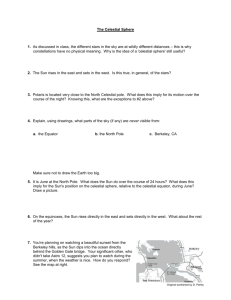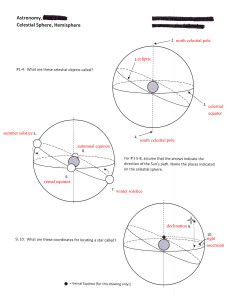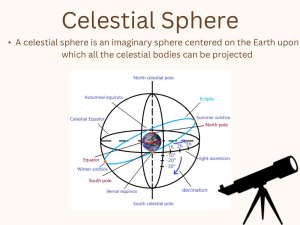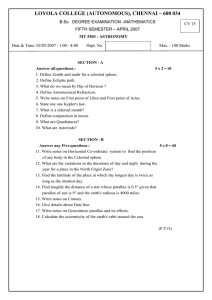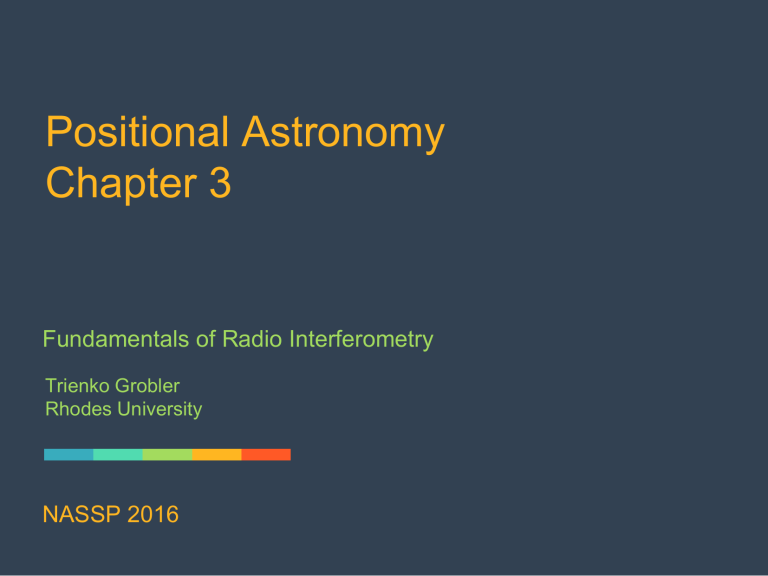
Positional Astronomy Chapter 3 Fundamentals of Radio Interferometry Trienko Grobler Rhodes University NASSP 2016 Outline ● Spherical Trigonometry ● Geographical Coordinates ● Equatorial Coordinates ● Hour Angle and Local Sidereal Time ● Horizontal Coordinates ● Direction Cosine Coordinates Spherical Trigonometry ● ● ● ● Spherical trigonometry is a branch of spherical geometry in which we study the relationship between the sides and angles of spherical triangles. Spherical triangles are formed by the pairwise intersection of three great circular arcs in three vertices. A great circular arc is an arc segment of a great circle. A great circle is formed by the intersection of a sphere and a plane that passes through the centre of the sphere. Spherical Trigonometric Identities Spherical Cosine Rule: Spherical Sine Rule: Five Part Rule: NB - We use the following trigonometric identities to convert between astronomical coordinate systems! Geographical Coordinate System ● ● We can use a geographical coordinate system to uniquely identify a position on earth. We normally use the coordinates latitude (to measure north and south) and longitude (to measure east and west) to accomplish this. Celestial Sphere ● ● ● ● ● ● ● For all intents and purposes we may think of our universe as being projected onto a sphere of arbitrary radius. This sphere surrounds the Earth and is known as the celestial sphere. The celestial equator is obtained by projecting the equator of the earth onto the celestial sphere. The stars themselves do not move on the celestial sphere and therefore have a unique location on it (at least not much in one generation). The sun is an exception, it changes position in a periodic fashion during the year. The path it traverses on the celestial sphere is known as the ecliptic. The north celestial pole (NCP) is an important location on the celestial sphere and is obtained by projecting the north pole of the earth onto the celestial sphere. The south celestial pole (SCP) is obtained in a similar way. Vernal Equinox ● ● ● We use a specific point on the celestial equator from which we measure the location of all other celestial objects. This point is known as the first point of Aries or the vernal equinox. The vernal equinox is the point where the ecliptic intersects the celestial equator (south to north). Celestial Coordinates ● ● Right Ascension - We define the hour circle of an object as the circle on the celestial sphere that crosses the NCP and the object itself, while also perpendicularly intersecting with the celestial equator. The right ascension of an object is the angular distance between the vernal equinox and the hour circle of a celestial object measured along the celestial equator and is measured eastward. It is measured in hours:minutes:seconds. Declination - the declination of an object is the angular distance from the celestial equator measured along its hour circle (it is positive in the northern celestial hemisphere and negative in the southern celestial hemisphere). It is measured in degrees:arcmin:arcsec. Local Meridian ● ● ● ● Zenith is the position on the celestial sphere which lies directly above an observer on earth. Nadir is the position on the celestial sphere which lies directly below an observer on earth. The local meridian is the hour circle on the celestial sphere which we form when we connect the NCP with zenith. Celestial objects rise in the east reach their highest point when they cross the local meridian (we say they are at transit) and set in the west. Hour Angle ● The hour angle of a celestial body is the angular distance (measured in hours) between the hour circle of a celestial object and the local meridian measured along the celestial equator in a westerly direction. Local Sidereal Time ● ● ● Astronomers use a sidereal time-keeping system to keep track of the vernal equinox (instead of the sun). The hour angle of the first point of Aries is your local sidereal time. There exists a simple relation between the hour angle of a celestial body and your local sidereal time which is given by: Sidereal Day ● ● ● ● ● ● Why do we need separate time-keeping systems to keep track of the stars and the sun? A sidereal day is 4 minutes shorter than a solar day. A solar day is the time it takes for the sun to return to the same position in the sky, while a sidereal day is the amount of time it takes for an arbitrary star to return to the same location in the sky. When the sun reappears at the same location in the sky (after 24 hours) it appears to have moved on the celestial sphere (it has moved relative to the background stars). The apparent movement of the sun on the celestial sphere is due to the fact that the earth needs to complete a little bit more than one full rotation for the sun to reappear at the same position in the sky which in turn comes about due to the fact that the earth orbits the sun. Since the background stars are much further away the earth only needs one full rotation (23 hours and 56 minutes) for an arbitrary star to reappear at the same position in the sky. Sidereal versus Solar Day Revisiting the Vernal Equinox ● ● ● Sun appears to move on the celestial sphere (the path it traverses is known as the ecliptic). The vernal equinox is the point on the celestial sphere where the sun crosses the celestial equator from south to north. The vernal equinox is currently in Pisces, but used to be in Aries. Which is why it is also known as the first point of Aries. It has moved due to precession. Horizontal Coordinates ● ● ● The horizontal coordinates: azimuth and altitude (elevation) is used to enable an observer on earth to locate celestial objects in the observer's local sky. The observer's horizontal plane is the fundamental plane of this coordinate system and is known as the celestial horizon. The azimuth angle is measured in the celestial horizon from due north towards the east, while the altitude of a celestial object is the angle between it and the celestial horizon. Both azimuth and elevation is measured in degrees. Conversion: Horizontal/Equatorial ∆ZPC – zenith-ncp-source spherical triangle ● (1) – five part rule ● (2) – sine rule ● (3) – cosine rule Red – horizontal plane Blue – equatorial plane Direction Cosine Coordinates ● ● ● The direction cosine coordinate system is quite powerful and allows us to redefine the fundamental reference point on the celestial sphere, from which we measure all other celestial objects, to an arbitrary location (i.e. we can make local sky-maps around our own chosen reference point; the vernal equinox need not be our fundamental reference point). Usually this arbitrary location is chosen to be the celestial source that we are interested in observing. We generally refer to this arbitrary location as the field-center. The direction cosine coordinate system is useful for another reason, when we use it to image interferometric data, then it becomes evident that there exists a Fourier relationship between the sky brightness function and the measurements that an interferometer makes Direction Cosines ● We use three coordinates in the direction cosine coordinate system, namely l, m and n. The coordinates l, m and n are dimensionless direction cosines: If |a|=1, then we can simply relabel x, y, z to l, m and n. Direction cosines can also be Cartesian coordinates. Conversion: Direction Cosine\Equatorial We derive the conversion Equations below, by applying the spherical trigonometric identities to the source-field center-NCP triangle (in the left Image). ● n points toward the field center. Red –equatorial plane ● Blue – lm plane Direction Cosines: Another interpretation ● ● If we project the direction cosine position vector s=(l,m,n) of a celestial body onto the lm-plane its projected length will be equal to sin(θ), where θ is the angular distance between your field-center sc and s measured along the surface of the celestial sphere. If θ is small we may use the small angle approximation, i.e. sin(θ) ≈ θ. The projected length of s is also equal to √(l2+m2), implying that l2+m2 ≈ θ2. We may therefore loosely interpret √(l2+m2) as the angular distance measured between the source at s and the fieldcenter sc measured along the surface of the celestial sphere, i.e. we may measure l and m in º. Units of l and m Direction cosines: Summary ● ● ● Direction cosines: l, m and n are direction cosines. Cartesian coordinates: l, m and n are Cartesian coordinates if we work on the unit sphere. Angular distance: √(l2+m2) denotes the angular distance θ, (l,m,n) is from the field-center (if θ is sufficiently small). [Title of Reading Further light page] ● Practical Astronomy with your calculator or spreadsheet ● Foundations of Astronomy ● Introductory Astronomy and Astrophysics
